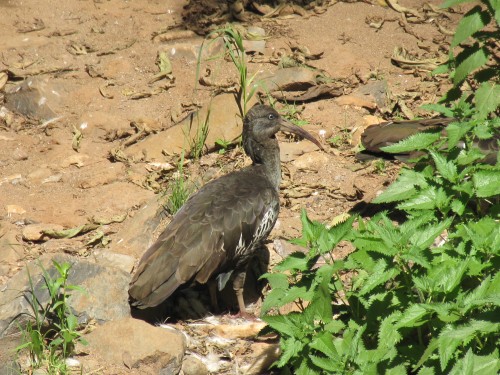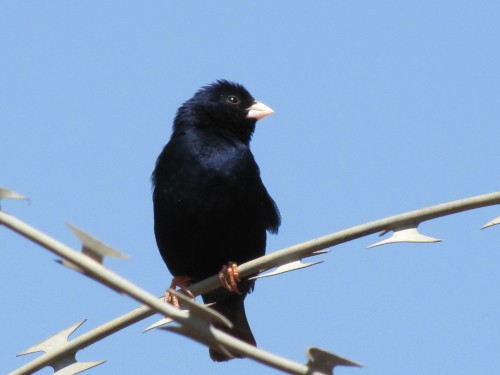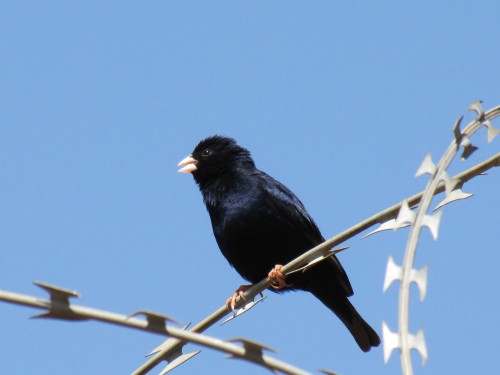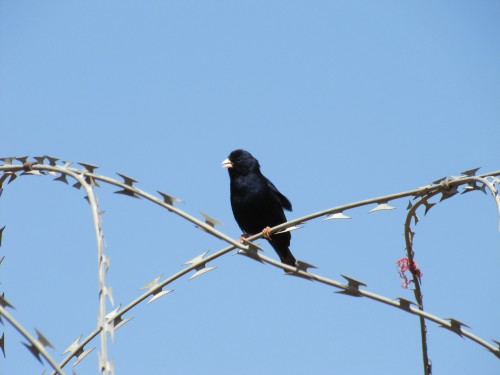Wattled Ibis, Addis Ababa, Ethiopia
One of the interesting birds I saw last December during my stay with my daughter in Addis Ababa was the Wattled Ibis. It was the only species of ibis I saw during my short visit despite the fact that 7 different species can be found in Eastern Africa.
The birds in these photos were taken along the river which flows along one boundary of the school campus where we were staying. Only in the last photo on this page can you easily see the wattle hanging from the throat of the birds. The Wattled Ibis is a bird of the highlands in Ethiopia – usually above 1500 metres – and is quite common. It has also been recorded in nearby Eritrea. While I only saw two birds at a time it is commonly seen in medium sized flocks of 20 – 100.
When feeding it will walk along slowly, prodding the ground for insects, worms, beetles and will take frogs, mice and even small snakes.
Village Indigobird, Addis Ababa, Ethiopia
The Village Indigobird I saw in Addis Ababa, Ethiopia is quite a stunning bird. The black coloured male feathers literally glow in sunlight. Few black coloured birds are quite as brilliant in my opinion. The female – which I didn’t get a chance to photograph – is dull brown, similar to a female House Sparrow.
Village Indigobirds are found over a wide part of Africa south of the Sahara Desert. They are found in bushland, woodlands, cultivated areas and especially around villages – hence the name. Their principal food is seed, especially grain. Being parasitic, the female lays her eggs in the nest of the Red-billed Firefinch (click to see my previous post), so these two species are usually seen in the same area. Unlike the cuckoos, however, the Indigobird does not remove the eggs of the host species.
I should perhaps explain the presence of the razor wire in these photos. The photos were taken inside the campus of the international school, Bingham Academy in Addis Ababa where my daughter was teaching last year. The large school campus is surrounded by a high 3m wall topped in razor wire for security purposes. All visitors and students need to enter through a 24 hour guarded gate. While there have been no incidents that I am aware of, the administrators take security seriously.
Red-billed Firefinch, Addis Ababa, Ethiopia
During my stay in Addis Ababa, Ethiopia last December I frequently saw the beautiful Red-billed Firefinch. This species was very common in the grounds of the school where my daughter was teaching. The extensive grounds were ideal for this seed-eating species and they were often encountered in grassy areas, on or near the school oval and on the lawns next to the classrooms.
The Red-billed Firefinch is also very common throughout sub-Sahara Africa. It is often found in open grassland and cultivated areas. The nest is a domed grass structure with an entrance on the side. The nest is parasitised by the Village Indigobird which was also present on the school campus. (I’ll feature that species in a few days’ time.)
Interestingly I didn’t get any photos of the female of this species. Females are a uniform brown colour all over, except for a red eyebrow and red on the rump.
Rock Martins and other birds, Ethiopia
Over recent days I have written about some of the birds I saw on a visit to the Portuguese Bridge area (near Debre Libanos) which is about 110km north of Addis Ababa in Ethiopia. There is some controversy over the old bridge (shown above). Local guides claim it was built by the Portuguese about 400 years ago. Other authorities claim that it was built more recently.
We were visiting the area last December. Geologically it is a very interesting place. We had wonderful views over the valley and down into the Blue Nile Gorge about 1000 metres below us. I’ve included no bird photos today – only scenery shots of this amazing place.
I saw a good number of birds and if you look through recent posts here you will see photos of some of them. Instead of bird photos I have compiled an annotated list of some of the birds seen:
- Pied Crow – numerous
- Fan-tailed Raven – 3 flying overhead
- Lammergeier – 1 soaring on thermals overhead
- Yellow-billed Kites – numerous – about 20 – 30 swooping low over people eating lunch. One took food from my fingers!
- Dusky Turtledove – about 5 seen
- Speckled Pigeon – only 1 seen
- Tacazza Sunbird – 2
- Rock Martin – about 10 swooping around the cliff edges
- Blue-breasted Bee-eater – 2 seen swooping for insects and then sitting on a branch
- Augur Buzzard – one seen only briefly, flying overhead
I saw and heard a number of other species but either didn’t get good views of them or no views at all. One of the more frustrating sightings was that of the Rock Martins swooping around the cliff edges. They came quite close – close enough for good identification – but none settled down to perch so I could get a photo. On the wing they were too swift to focus on. [Sigh]
So – you’ll have to be content with some lovely scenery shots instead. But stay tuned for more photos taken elsewhere in the coming days.
Blue-breasted Bee-eater, Ethiopia
One of my favourite Australian birds would have to be the Rainbow Bee-eater (click here for a photo). They are regular spring and summer visitors to our garden and even occasionally breed on our 5 acre block of land. When I visited Nepal a few years ago I had a brief glimpse of the Blue-bearded Bee-eater and the Green Bee-eater while visiting Chitwan National Park in the southern part of the country.
Before travelling to Africa late last year I knew that several species of bee-eaters could be seen there, so I hoped that I would get good views of at least one species. I was rewarded with not only a good sighting but several photos as well. The Blue-breasted Bee-eater shown in today’s photos is every part as spectacular as the other species I had already seen. The two birds sat obligingly on a branch in full view and in full sunlight until I had some shots. They then continued on hawking for insects.
These birds were seen at the locality known as Portuguese Bridge, about 110km north of Addis Ababa in Ethiopia.
Further reading:















